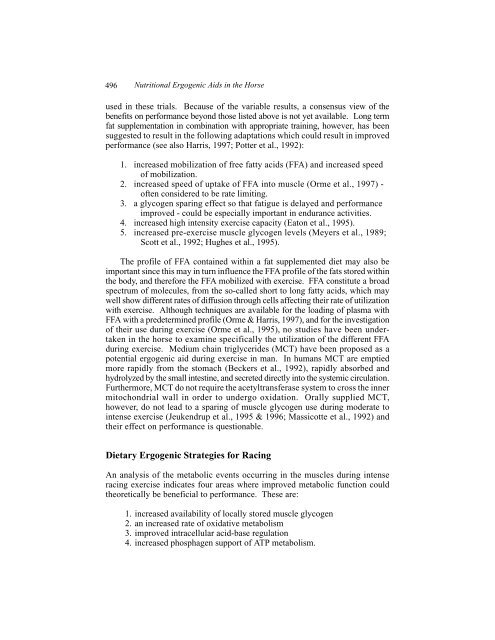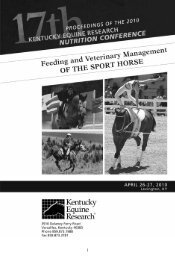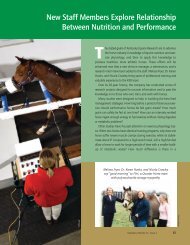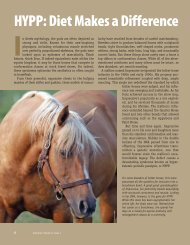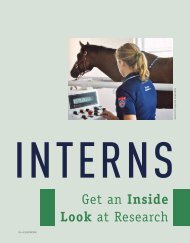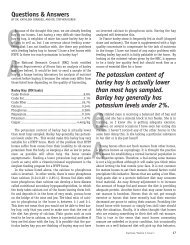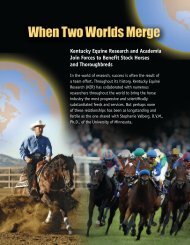Nutritional Ergogenic Aids in the Horse - Kentucky Equine Research
Nutritional Ergogenic Aids in the Horse - Kentucky Equine Research
Nutritional Ergogenic Aids in the Horse - Kentucky Equine Research
- No tags were found...
Create successful ePaper yourself
Turn your PDF publications into a flip-book with our unique Google optimized e-Paper software.
496 <strong>Nutritional</strong> <strong>Ergogenic</strong> <strong>Aids</strong> <strong>in</strong> <strong>the</strong> <strong>Horse</strong>used <strong>in</strong> <strong>the</strong>se trials. Because of <strong>the</strong> variable results, a consensus view of <strong>the</strong>benefits on performance beyond those listed above is not yet available. Long termfat supplementation <strong>in</strong> comb<strong>in</strong>ation with appropriate tra<strong>in</strong><strong>in</strong>g, however, has beensuggested to result <strong>in</strong> <strong>the</strong> follow<strong>in</strong>g adaptations which could result <strong>in</strong> improvedperformance (see also Harris, 1997; Potter et al., 1992):1. <strong>in</strong>creased mobilization of free fatty acids (FFA) and <strong>in</strong>creased speedof mobilization.2. <strong>in</strong>creased speed of uptake of FFA <strong>in</strong>to muscle (Orme et al., 1997) -often considered to be rate limit<strong>in</strong>g.3. a glycogen spar<strong>in</strong>g effect so that fatigue is delayed and performanceimproved - could be especially important <strong>in</strong> endurance activities.4. <strong>in</strong>creased high <strong>in</strong>tensity exercise capacity (Eaton et al., 1995).5. <strong>in</strong>creased pre-exercise muscle glycogen levels (Meyers et al., 1989;Scott et al., 1992; Hughes et al., 1995).The profile of FFA conta<strong>in</strong>ed with<strong>in</strong> a fat supplemented diet may also beimportant s<strong>in</strong>ce this may <strong>in</strong> turn <strong>in</strong>fluence <strong>the</strong> FFA profile of <strong>the</strong> fats stored with<strong>in</strong><strong>the</strong> body, and <strong>the</strong>refore <strong>the</strong> FFA mobilized with exercise. FFA constitute a broadspectrum of molecules, from <strong>the</strong> so-called short to long fatty acids, which maywell show different rates of diffusion through cells affect<strong>in</strong>g <strong>the</strong>ir rate of utilizationwith exercise. Although techniques are available for <strong>the</strong> load<strong>in</strong>g of plasma withFFA with a predeterm<strong>in</strong>ed profile (Orme & Harris, 1997), and for <strong>the</strong> <strong>in</strong>vestigationof <strong>the</strong>ir use dur<strong>in</strong>g exercise (Orme et al., 1995), no studies have been undertaken<strong>in</strong> <strong>the</strong> horse to exam<strong>in</strong>e specifically <strong>the</strong> utilization of <strong>the</strong> different FFAdur<strong>in</strong>g exercise. Medium cha<strong>in</strong> triglycerides (MCT) have been proposed as apotential ergogenic aid dur<strong>in</strong>g exercise <strong>in</strong> man. In humans MCT are emptiedmore rapidly from <strong>the</strong> stomach (Beckers et al., 1992), rapidly absorbed andhydrolyzed by <strong>the</strong> small <strong>in</strong>test<strong>in</strong>e, and secreted directly <strong>in</strong>to <strong>the</strong> systemic circulation.Fur<strong>the</strong>rmore, MCT do not require <strong>the</strong> acetyltransferase system to cross <strong>the</strong> <strong>in</strong>nermitochondrial wall <strong>in</strong> order to undergo oxidation. Orally supplied MCT,however, do not lead to a spar<strong>in</strong>g of muscle glycogen use dur<strong>in</strong>g moderate to<strong>in</strong>tense exercise (Jeukendrup et al., 1995 & 1996; Massicotte et al., 1992) and<strong>the</strong>ir effect on performance is questionable.Dietary <strong>Ergogenic</strong> Strategies for Rac<strong>in</strong>gAn analysis of <strong>the</strong> metabolic events occurr<strong>in</strong>g <strong>in</strong> <strong>the</strong> muscles dur<strong>in</strong>g <strong>in</strong>tenserac<strong>in</strong>g exercise <strong>in</strong>dicates four areas where improved metabolic function could<strong>the</strong>oretically be beneficial to performance. These are:1. <strong>in</strong>creased availability of locally stored muscle glycogen2. an <strong>in</strong>creased rate of oxidative metabolism3. improved <strong>in</strong>tracellular acid-base regulation4. <strong>in</strong>creased phosphagen support of ATP metabolism.


